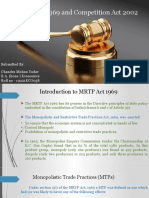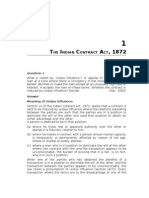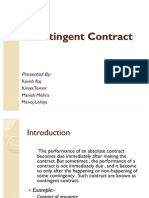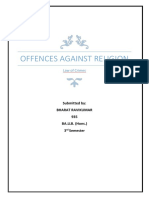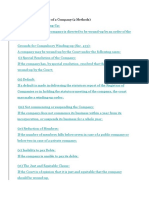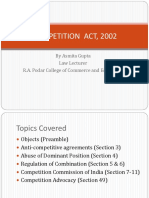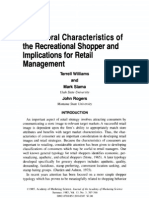Remedies and Relief Under Consumer Protection Act, 2019
Remedies and Relief Under Consumer Protection Act, 2019
Uploaded by
Shivani AntilCopyright:
Available Formats
Remedies and Relief Under Consumer Protection Act, 2019
Remedies and Relief Under Consumer Protection Act, 2019
Uploaded by
Shivani AntilOriginal Description:
Original Title
Copyright
Available Formats
Share this document
Did you find this document useful?
Is this content inappropriate?
Copyright:
Available Formats
Remedies and Relief Under Consumer Protection Act, 2019
Remedies and Relief Under Consumer Protection Act, 2019
Uploaded by
Shivani AntilCopyright:
Available Formats
Remedies and Relief under
Consumer Protection Act, 2019
The Consumer Protection Act, 1986 was enacted to provide for better protection of the interests
of consumers and for the purpose of making provision for establishment of consumer protection
councils and other authorities for the settlement of consumer disputes, etc. Although, the
working of the consumer dispute redressal agencies has served the purpose to a considerable
extent under the said Act, the disposal of cases has not been fast due to various constraints.
Consumer markets for goods and services have undergone drastic transformation since the
enactment of the Consumer Protection Act in 1986. The modern marketplace contains a plethora
of products and services. The emergence of global supply chains, rise in international trade and
the rapid development of e-commerce have led to new delivery systems for goods and services
and have provided new options and opportunities for consumers. Equally, this has rendered the
consumer vulnerable to new forms of unfair trade and unethical business practices. Misleading
advertisements, tele-marketing, multi-level marketing, direct selling and e-commerce pose new
challenges to consumer protection and will require appropriate and swift executive interventions
to prevent consumer detriment.
KEY FEATURES OF CONSUMER PROTECTION ACT, 2019
Insertion of ‘Product liability’ provision to deter manufacturers and service providers from
delivering defective products or deficient services;
E-commerce included within the ambit of Consumer Protection Act.
Establishment of Central Consumer Protection Authority (CCPA);
Simplified dispute resolution process with substantial increase in pecuniary jurisdiction of
consumer protection commissions;
Introduction of new additional grounds to file complaints and imposition of higher penalties to
keep in check misleading advertisements and adulteration of products.
NEW REMEDIES FORMULATED
Removal Of Defects: If after proper testing the product proves to be defective, then the
‘remove its defects’ order can be passed by the authority concerned.
Replacement of Goods
Refund of Price
Award of Compensation: If because of the negligence of the seller a consumer suffers
physical or any other loss, then compensation for that loss can be demanded for.
Removal of Deficiency in Service: If there is any deficiency in delivery of service, then
orders can be passed to remove that deficiency. For instance, if an insurance company
makes unnecessary delay in giving final touch to the claim, then under this Act orders can
be passed to immediately finalise the claim.
Discontinuance of Unfair/Restrictive Trade Practice: If a complaint is filed against
unfair/restrictive trade practice, then under the Act that practice can be banned with
immediate effect. For instance, if a gas company makes it compulsory for a consumer to
buy gas stove with the gas connection, then this type of restrictive trade practice can be
checked with immediate effect.
Stopping of sale of Hazardous Goods
Withdrawal of Hazardous Goods from the market.
Payment of Adequate Cost
OLD LAW vs. NEW LAW
FEATURES 1986 2019
1. Ambit of law All goods and services for All goods and services, including
consideration, while free and telecom and housing construction, and
personal services are all modes of transactions (online,
excluded teleshopping, etc.) for consideration.
Free and personal services are
excluded.
2. Unfair trade practices Includes six types of such Adds three types of practices to the
(Defined as deceptive practices practices, like false list,(i) failure to issue a bill or receipt;
to promote the sale, use or representation, misleading (ii) refusal to accept a good returned
supply of a good or service.) advertisements. within 30 days; and (iii) disclosure of
personal information given in
confidence, unless required by law or
in public interest.
Contests/ lotteries may be notified as
not falling under the ambit of unfair
trade practices.
3. Product liability No provision. Claim for product liability can be
made against manufacturer, service
provider, and seller.
4. Unfair contracts No provision. Defined as contracts that cause
significant change in consumer rights.
Lists six contract terms which may be
held as unfair.
5. Central Protection CPCs promote and protect The new Bill makes CPCs advisory
Councils (CPCs) the rights of consumers. bodies for promotion and protection
They are established at the of consumer rights. Establishes CPCs
district, state, and national at the district, State and national level.
level.
6. Regulator No provision. Central Consumer Protection
Authority (CCPA) to promote,
protect, and enforce the rights of
consumers as a class.
7. Pecuniary jurisdiction of District: Up to Rs 20 lakh; District Commission –Up to Rs1 crore
Commissions State: Between Rs 20 lakh State Commission- Between Rs1
crore and Rs 10 crore
and up to Rs one crore;
National Commission –Above Rs.10
National: Above Rs one crore
crore.
8. Composition of District: Headed by current District: Headed by a president and at
Commissions or former District Judge and least two members.
two members. State: Headed by a president and at
State: Headed by a current least four members.
or former High Court Judge
and at least two members. National: Headed by a president and
at least four members.
National: Headed by a
current or former Supreme
Court Judge and at least four
members.
9. Appointment Selection Committee No provision for Selection
(comprising a judicial Committee. Central government will
member and other officials) appoint through notification.
will recommend members on
the Commissions.
10. Alternate dispute redressal No provision. Mediation cells will be attached to the
mechanism District, State, and National
Commissions.
11. Penalties If a person does not comply If a person does not comply with
with orders of the orders of the Commissions, he may
Commissions, he may face face imprisonment up to three years,
imprisonment between one or a fine not less than Rs 25,000
month and three years or fine extendable to Rs one lakh, or both.
between Rs. 2,000 to Rs.
10,000, or both.
12. E-commerce No provision. Defines direct selling, e-commerce
and electronic service provider. The
central government may prescribe
rules for preventing unfair trade
practices in e-commerce and direct
selling.
CONCLUSION
As is evident, CPA 2019 has made several changes to the erstwhile CPA 1986. CPA 2019 has
widened the reach of consumer protection regime in India. The changes made vide CPA 2019
seem to further empower consumers by leveraging responsibilities not only on their counterparts,
i.e., the sellers, manufacturers, service providers, but also the endorsers of such products. It also
attempts to address the issues that were not comprehensively touched upon by CPA 1986, such
interests of consumers as a class, etc.
CPA 2019 has also attempted to ease and fasten the process of consumer disputes resolution by
increasing the pecuniary jurisdiction of the commissions, attaching mediation cells, increasing
the members of the commissions, imposing higher penalties etc. Keeping pace with changing
times and new legislations aimed at protecting the interests en masse, the present bill has
successfully broadened the scope of various provisions, including persons who can file a
consumer complaint to also include class action. This would better protect the rights and interests
of the consumers who are not legally equipped to fight for their rights.
The ramifications of CPA 2019 cannot be precisely gauged beforehand, as many new concepts
have been introduced. However, what can definitely be said is that everyone involved in a
transaction, other than the consumer, will have to be more careful, and cautious than ever before.
You might also like
- Earn Over 100k Joe Verde PDFDocument186 pagesEarn Over 100k Joe Verde PDFdomini809No ratings yet
- 1 Which of The Following Is The Least Important Area in Which To Include Your KeywordDocument20 pages1 Which of The Following Is The Least Important Area in Which To Include Your KeywordVipul Goel100% (1)
- Everyone's Guide To Online Dating (RARE)Document190 pagesEveryone's Guide To Online Dating (RARE)O_______o78% (9)
- Mr. Ferris and His Wheel Educator GuideDocument7 pagesMr. Ferris and His Wheel Educator GuideHoughton Mifflin HarcourtNo ratings yet
- Vodafone Case StudyDocument6 pagesVodafone Case StudyVenkatkrishna PicharaNo ratings yet
- Registration Completed SuccessfullyDocument3 pagesRegistration Completed SuccessfullySukrit JainNo ratings yet
- Presentation / Digital Strategy at Sydney Opera House - Victoria DoidgeDocument39 pagesPresentation / Digital Strategy at Sydney Opera House - Victoria DoidgeAustralia Council for the ArtsNo ratings yet
- Thesis Marketing Strategies of Cadbury India LimitedDocument83 pagesThesis Marketing Strategies of Cadbury India LimitedPitabash BeheraNo ratings yet
- Possibility of Performance and Terms of ContractDocument27 pagesPossibility of Performance and Terms of ContractSnr Berel ShepherdNo ratings yet
- Consumer Protection Act 2019Document36 pagesConsumer Protection Act 2019Vandana NayakNo ratings yet
- Aims and Objectives of The Consumer Protection Act, 1986Document12 pagesAims and Objectives of The Consumer Protection Act, 1986Ubaid MirNo ratings yet
- The Contract Labour (Regulation and Abolition) ACT, 1970Document37 pagesThe Contract Labour (Regulation and Abolition) ACT, 1970sunaina754No ratings yet
- Jamia Millia Islamia: Does Mere Silence Amount To Fraud or Not?Document11 pagesJamia Millia Islamia: Does Mere Silence Amount To Fraud or Not?Shabih FatimaNo ratings yet
- ConsiderationDocument55 pagesConsiderationAmarnath Ashok VibhuteNo ratings yet
- Constitutional Provision Governing Taxation in IndiaDocument3 pagesConstitutional Provision Governing Taxation in IndiaAnonymous H1TW3YY51KNo ratings yet
- MRTP Act 1969 and Competition Act 2002: Chandra Mohan Yadav B.A. (Hons.) Economics Roll No - 19221ECO058 Submitted byDocument20 pagesMRTP Act 1969 and Competition Act 2002: Chandra Mohan Yadav B.A. (Hons.) Economics Roll No - 19221ECO058 Submitted bysaurabh yadavNo ratings yet
- Insurance OmbudsmanDocument2 pagesInsurance OmbudsmanVivek GuptaNo ratings yet
- Labour Law Project On Workman: Prepared byDocument31 pagesLabour Law Project On Workman: Prepared byrajeevrvs083No ratings yet
- Essential Elements of A Valid ContractDocument14 pagesEssential Elements of A Valid ContractdevilzniteinNo ratings yet
- Labour & Industrial Law - Internal Assessment 2: Irac - Vividh Kamgarh Sabha V. Kalyani Steels LTD., (2001) 2 SCC 381Document4 pagesLabour & Industrial Law - Internal Assessment 2: Irac - Vividh Kamgarh Sabha V. Kalyani Steels LTD., (2001) 2 SCC 381Srishti OraonNo ratings yet
- Payment of Wages Act 1936Document22 pagesPayment of Wages Act 1936Vetri Velan100% (1)
- Strikes and Lockouts: Presented By: Nikita Begum TalukdarDocument50 pagesStrikes and Lockouts: Presented By: Nikita Begum Talukdarsanjana seth100% (2)
- Chapter-1 The Indian Contract Act, 1872Document31 pagesChapter-1 The Indian Contract Act, 1872Anand_Agrawal19100% (1)
- Indian Contract Act 1872Document31 pagesIndian Contract Act 1872MITRA SIMRAN ANEEL 2010331No ratings yet
- Banking FDDocument17 pagesBanking FDKumar SouravNo ratings yet
- MTP, RTP and UTP - AssignmentDocument2 pagesMTP, RTP and UTP - AssignmentAman D Sharan100% (1)
- Banking Project-Section 138 Negotiable Instruments ActDocument10 pagesBanking Project-Section 138 Negotiable Instruments ActSrinjoy BhattacharyaNo ratings yet
- MRTP ACT - Monopolies and Restrictive Trade Practices ACT-1969Document9 pagesMRTP ACT - Monopolies and Restrictive Trade Practices ACT-1969Gopalakrishnan SivaramNo ratings yet
- Income From Business or ProfessionDocument7 pagesIncome From Business or ProfessionSwathi JayaprakashNo ratings yet
- 100 Landmark Cases On ConstitutionDocument19 pages100 Landmark Cases On Constitutionzz9805621No ratings yet
- Competition Act, 2002Document11 pagesCompetition Act, 2002Somya AgrawalNo ratings yet
- Minimum Wages Act 1948Document4 pagesMinimum Wages Act 1948NIHARIKA PARASHARNo ratings yet
- Section 74 of Indian Contract ActDocument9 pagesSection 74 of Indian Contract ActParshva ShahNo ratings yet
- Contract 2 ResearchDocument21 pagesContract 2 ResearchNCLTNo ratings yet
- Aids To InterpretationDocument68 pagesAids To InterpretationWWWEEEENo ratings yet
- The Contract Labour (Regulation and Abolition) Act, 1970: Presented By: Ajay Krishna S4 MbaDocument32 pagesThe Contract Labour (Regulation and Abolition) Act, 1970: Presented By: Ajay Krishna S4 Mbavaishu nairNo ratings yet
- Objective and Scope of Industrial EmployDocument9 pagesObjective and Scope of Industrial EmployLakshmi Narayan RNo ratings yet
- Lay-Off and Retrenchment Under Industrial Disputes Act, 1947Document12 pagesLay-Off and Retrenchment Under Industrial Disputes Act, 1947Shayan ZafarNo ratings yet
- The Employees - Compensation Act 1923Document108 pagesThe Employees - Compensation Act 1923Saurabh RajNo ratings yet
- Contingent ContractDocument16 pagesContingent ContractPratik Raj100% (1)
- Raghavan Committee ReportDocument13 pagesRaghavan Committee ReportAngel AngelNo ratings yet
- Free Consent: Coercion, Undue Influence, Fraud, Misrepresentation and MistakeDocument26 pagesFree Consent: Coercion, Undue Influence, Fraud, Misrepresentation and MistakeVanshdeep Kaur SaranNo ratings yet
- Assignmengt On Free ConsentDocument11 pagesAssignmengt On Free ConsentKamaku SoftNo ratings yet
- Contingent ContractsDocument7 pagesContingent ContractsTanvir Sadik AkashNo ratings yet
- Fema (Foreign Exchange Management ActDocument25 pagesFema (Foreign Exchange Management ActMayank GargNo ratings yet
- Banking Law Garnishee Order 2Document14 pagesBanking Law Garnishee Order 2ÄbhíñävJäíñ100% (2)
- Contract of GuaranteeDocument17 pagesContract of Guaranteerahul rajNo ratings yet
- Compendium On Landmark Cases: Trade Mark: AuthorsDocument45 pagesCompendium On Landmark Cases: Trade Mark: AuthorsPrateek Chahar100% (1)
- Competition Law Assignment by Ritika ShriwastavDocument18 pagesCompetition Law Assignment by Ritika ShriwastavSaurabh KumarNo ratings yet
- Offences Against ReligionDocument35 pagesOffences Against ReligionZeeshan AhmadNo ratings yet
- Modes of WindingDocument14 pagesModes of WindingAayushNo ratings yet
- Rangaswami CaseDocument5 pagesRangaswami Casevikhyat2010No ratings yet
- Economics ProjectDocument15 pagesEconomics ProjectJasmine KaurNo ratings yet
- Competition-Act - 2002Document17 pagesCompetition-Act - 2002hareshNo ratings yet
- A Critical Study On Role of Adr in Consumer Protection IndiaDocument13 pagesA Critical Study On Role of Adr in Consumer Protection IndiaRaghav DhootNo ratings yet
- Foreign Trade Law: The Agreement On Trade-Related Investment Measures (Trims)Document15 pagesForeign Trade Law: The Agreement On Trade-Related Investment Measures (Trims)TanuNo ratings yet
- Free Consent Under The Indian Contract Act, 1872Document18 pagesFree Consent Under The Indian Contract Act, 1872theashu022No ratings yet
- 1 "All Agreements Are Not Contracts, But All Contracts Are Agreements". CommentDocument15 pages1 "All Agreements Are Not Contracts, But All Contracts Are Agreements". CommentSiddhartha GuptaNo ratings yet
- Notes BA LLB VI Sem - COMPETITION LAWDocument6 pagesNotes BA LLB VI Sem - COMPETITION LAWbeejal ahujaNo ratings yet
- I R CoheloDocument5 pagesI R CoheloHarsh PathakNo ratings yet
- Registration of Firms (Ss 56-71), Chapter-VII: Law of Contracts-IIDocument5 pagesRegistration of Firms (Ss 56-71), Chapter-VII: Law of Contracts-IIShubham PhophaliaNo ratings yet
- Services Under The Union and The StatesDocument9 pagesServices Under The Union and The StatesPrachi TripathiNo ratings yet
- Basis of Charge and Scope of TotalDocument24 pagesBasis of Charge and Scope of TotalSujithNo ratings yet
- Consumer Protection ActDocument11 pagesConsumer Protection ActSiva Ganga SivaNo ratings yet
- Consumer Protection Act, 2019Document29 pagesConsumer Protection Act, 2019Dr A. K. SubramaniNo ratings yet
- Unit 3 Part2Document12 pagesUnit 3 Part2Soumya RathoreNo ratings yet
- Differences Between 1986 Act and 2019 ActDocument11 pagesDifferences Between 1986 Act and 2019 Actproject mailNo ratings yet
- Introduction To Media LiteracyDocument16 pagesIntroduction To Media LiteracySay Say100% (1)
- Translations Company EVS Translations Services BrochureDocument2 pagesTranslations Company EVS Translations Services BrochureDesislava NikolovaNo ratings yet
- MM Assignment Group-9Document19 pagesMM Assignment Group-9divyesh jNo ratings yet
- Survey QuestionnaireDocument1 pageSurvey QuestionnaireasdfNo ratings yet
- PR Metrics PaperDocument36 pagesPR Metrics PapergagansrikankaNo ratings yet
- Case Analysis RayovacDocument4 pagesCase Analysis Rayovacmonika226No ratings yet
- Behavioral Characteristics of The Recreational Shopper and Implications For Retail ManagementDocument10 pagesBehavioral Characteristics of The Recreational Shopper and Implications For Retail ManagementAbdul QadoosNo ratings yet
- Haldiram CaseDocument5 pagesHaldiram CaseNikhil SinghalNo ratings yet
- Tracy Price Executive Assistant Office Manager in Chicago IL ResumeDocument2 pagesTracy Price Executive Assistant Office Manager in Chicago IL ResumeTracyPrice1No ratings yet
- Social Media Marketing Thesis - FinalDocument26 pagesSocial Media Marketing Thesis - FinalMehwash FatimaNo ratings yet
- Master of Business Administration: The Report On Summer-Internship at Suguna Foods Limited in VaratharajapuramDocument20 pagesMaster of Business Administration: The Report On Summer-Internship at Suguna Foods Limited in VaratharajapuramThilli KaniNo ratings yet
- CH 09Document34 pagesCH 09Pj Jn NavarroNo ratings yet
- EFFIE 2002 Case StudiesDocument16 pagesEFFIE 2002 Case Studies9986212378100% (1)
- JounalismDocument30 pagesJounalismjothiNo ratings yet
- Eng Vii PPT 1Document9 pagesEng Vii PPT 1vanessa castroNo ratings yet
- Celebrity FormatDocument1 pageCelebrity FormatyzkjrxbcjdNo ratings yet
- Marketing Notes (Selected Topics)Document19 pagesMarketing Notes (Selected Topics)Sajid AliNo ratings yet
- De Beers CaseDocument18 pagesDe Beers CaseMohd Ijlal AnjumNo ratings yet
- Vocabulario 100 Verbos Utilizados en Ingles de NegociosDocument1 pageVocabulario 100 Verbos Utilizados en Ingles de Negociosapi-383516350% (2)
- Data CoreDocument14 pagesData CoreJosé Luis GarcíaNo ratings yet
- Potential Study of Lubes in The Bazaar Sector FinalDocument82 pagesPotential Study of Lubes in The Bazaar Sector FinallakshmiNo ratings yet
- SM Supersonic Stereo ExhibitsDocument9 pagesSM Supersonic Stereo ExhibitsAshish MittalNo ratings yet
- Integrated Marketing Communications StrategyDocument54 pagesIntegrated Marketing Communications StrategyAshutosh SharmaNo ratings yet















